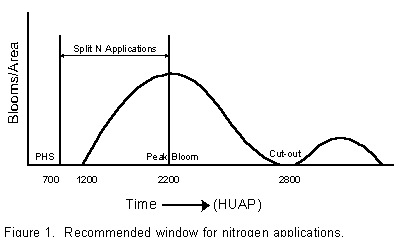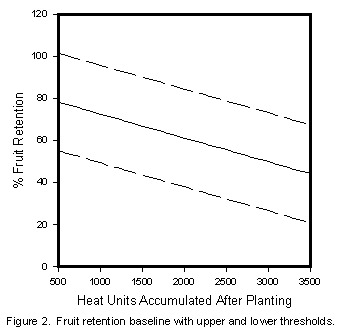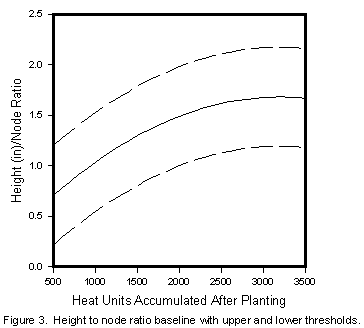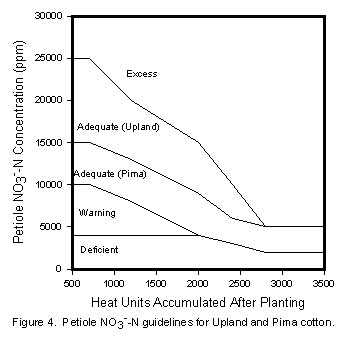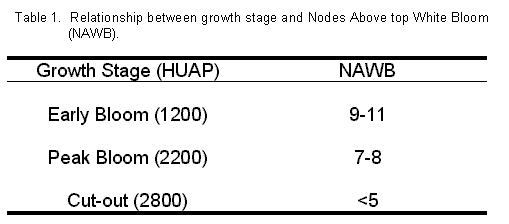Nitrogen Management for Cotton
(Publication az1200)
(PDF version, 40KB)
by Jeffrey C. Silvertooth,
Extension Agronomist - Cotton
Fertilizer nitrogen (N) represents a crop production input that should be used carefully in an effort to manage for optimum efficiency, high yields, and earliness. The most efficient use of fertilizer N (a high proportion of fertilizer N actually taken up and utilized by the crop) is achieved by providing the N at a time that the plant can use it. The N requirements of a cotton crop basically follow the same pattern as flowering or fruiting on the crop. Accordingly, N demand is very low early in the season, picks up through early fruiting, reaches a peak demand at peak bloom, and gradually declines as the crop approaches and proceeds through cut-out. A recommended window for applying split applications of fertilizer N to cotton is shown in Figure 1, beginning at first pinhead square formation and ending just prior to peak bloom.
Total N requirements will vary among fields and are related to realistic, projected yield goals, which can be estimated by using a N factor of 60 lbs. N/bale of cotton. Residual NO3- -N in the soil and any NO3- -N added to the crop through the irrigation water can be subtracted from the total estimated crop needs to determine the amount of fertilizer N needed. The total fertilizer N can then be applied by the use of split applications. By following crop development through the fruiting cycle, one can also anticipate periods of high N demand. The stage of crop development can be determined by counting nodes above the top white flower (NAWF) shown in Table 1, and/or by referring to heat units accumulated since planting (HUAP). Crop N demand is closely related to the fruit load on the plant. Basically, heavier boll loads demand more N. Therefore, an assessment of the crop fruit load can have a strong bearing on estimating N needs. Crop fruit retention (FR) patterns can be compared to established baselines for Arizona cotton (Figure 2). Since the FR level is directly related to crop N requirements, some assessment of crop vigor can provide an indication of this important aspect of the crop. A reliable measure of crop vigor can be obtained from a plant height (inches) to node ratio (HNR), which is taken from a simple measure of plant height from the cotyledon nodes, or base of the plant, to the terminal and counting the number of mainstem nodes. The resulting HNR can then be compared to the established baselines shown in Figure 3. The crop's actual N fertility status can be assessed by measuring the NO3- -N (nitrate -N) concentration in the petioles and referring to established and recently revised guidelines for both Upland and Pima cotton (Figure 4). One should make note of the differences between Upland and Pima cotton petiole guidelines, with Pima commonly running about 40% lower than Upland in NO3- -N concentrations. Using these tools or measurements, a grower can follow crop and fruit load development along with the actual N fertility status to make decisions about when and how much fertilizer N should be applied.
In the case of a crop in early bloom with a strong fruit load (FR and HNRs near the middle baselines shown in Figures 2 and 3) and an acceptable but declining level of NO3- -N in the petioles; an application of fertilizer N may very well be in order. On the other hand, if the crop was recognized to be losing fruit for some reason (drop in FR and HNRs trending toward or above the upper thresholds), N applications may need to be withheld or reduced. Additional N applied to a crop with a poor fruit load can easily serve to enhance vegetative growth tendencies.
Fertilizer N can be managed with some flexibility in response to actual crop condition. The split applications should be made in approximately 50 lb. N/acre increments toward meeting total needs based on a yield goal approach (i.e. 3 bale/acre projected yield X 60 lbs. N/bale = 180 lbs. N/acre total). Adjustments can be made depending on levels of preseason residual soil N, fertilizer N efficiencies, and crop condition.
Issued in furtherance of Cooperative Extension work, acts of May 8 and June 30, 1914, in cooperation with the U.S. Department of Agriculture, James A. Christenson, Director Cooperative Extension, College of Agriculture and Life Sciences, The University of Arizona.
The University of Arizona is an equal opportunity, affirmative action institution. The University does not discriminate on the basis of race, color, religion, sex, national origin, age, disability, veteran status, or sexual orientation in its programs and activities.
Any products, services, or organizations that are
mentioned, shown, or indirectly implied in this web document do not imply
endorsement by The University of Arizona.
Information provided by Jeffrey C. Silvertooth, silver@ag.arizona.edu
Extension Agronomist - Cotton, College of Agriculture, The University of Arizona.
Material written February 2001.
Home | Cotton | Advisories
document located at: http://cals.arizona.edu/crops/cotton/soilmgt/nitrogen_management.html
Copyright © 2001 University of Arizona,
College of Agriculture and Life Sciences
Webmaster: Al Fournier (acis@ag.arizona.edu)
